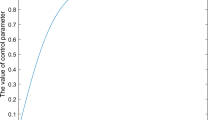Abstract
Multi-objective evolutionary algorithms (MOEAs) have been the choice for generating a set of Pareto-optimal (PO) solutions in one run. However, these algorithms sometimes suffer slow and poor convergence toward the PO front. One of the remedies to improve their convergence is to couple global search of MOEAs with local search. However, such coupling brings other implementation challenges, such as what, when, and how many solutions can be chosen for local search with MOEAs? In this paper, these challenges are addressed by developing a local search module that can choose solutions for local search using a set of reference lines. The heuristic strategies are also developed with the module for determining the frequency of executing local search and for terminating MOEA adaptively using a statistical performance indicator. The proposed algorithm, which is referred to as \({\text {RM}}^2\)OEA, is tested on 2-objective ZDT and 3-objective DTLZ test problems. Results demonstrate faster and improved convergence of \({\text {RM}}^2\)OEA over a benchmark MOEA from the literature.











Similar content being viewed by others
References
Barakat N, Sharma D (2019) Evolutionary multi-objective optimization for bulldozer and its blade in soil cutting. Int J Manag Sci Eng Manag 14(2):102–112
Bosman PAN (2012) On gradients and hybrid evolutionary algorithms for real-valued multiobjective optimization. IEEE Trans Evol Comput 16(1):51–69
Chen B, Zeng W, Lin Y, Zhang D (2015) A new local search-based multiobjective optimization algorithm. IEEE Trans Evol Comput 19(1):50–73. https://doi.org/10.1109/TEVC.2014.2301794
Das I, Dennis JE (1998) Normal-boundary intersection: a new method for generating the pareto surface in nonlinear multicriteria optimization problems. SIAM J Optim 8(3):631–657. https://doi.org/10.1137/S1052623496307510
Deb K, Agrawal RB (1995) Simulated binary crossover for continuous search space. Complex Syst 9(2):115–148
Deb K, Miettinen K, Chaudhuri S (2010) Toward an estimation of Nadir objective vector using a hybrid of evolutionary and local search approaches. IEEE Trans Evol Comput 14(6):821–841. https://doi.org/10.1109/TEVC.2010.2041667
Deb K, Miettinen K, Sharma D (2009) A hybrid integrated multi-objective optimization procedure for estimating Nadir point. In: Ehrgott M, Fonseca CM, Gandibleux X, Hao JK, Sevaux M (eds) Evolutionary multi-criterion optimization. Springer, Berlin, Heidelberg, pp 569–583
Deb K, Thiele L, Laumanns M, Zitzler E (2005) Scalable test problems for evolutionary multiobjective optimization. In: Abraham A, Jain L, Goldberg R (eds) Evolutionary multiobjective optimization: theoritical advances and applications. Springer, London, pp 105–145
Ishibuchi H, Masuda H, Nojima Y (2015) A study on performance evaluation ability of a modified inverted generational distance indicator. In: Proceedings of the 2015 annual conference on genetic and evolutionary computation. ACM, pp 695–702
Ishibuchi H, Murata T (1996) Multi-objective genetic local search algorithm. IEEE Trans Evol Comput 28:119–124
Ishibuchi H, Narukawa K (2004) Some issues on the implementation of local search in evolutionary multiobjective optimization. In: Deb K (ed) Genetic and evolutionary computation - GECCO 2004. Springer, Berlin, Heidelberg, pp 1246–1258
Ishibuchi H, Yoshida T, Murata T (2003) Balance between genetic search and local search in memetic algorithms for multiobjective permutation flowshop scheduling. IEEE Trans Evol Comput 7(2):204–222
Jaszkiewicz A (2002) Genetic local search for multi-objective combinatorial optimization. Eur J Oper Res 137(1):50–71. https://doi.org/10.1016/S0377-2217(01)00104-7
Ke L, Zhang Q, Battiti R (2014) Hybridization of decomposition and local search for multiobjective optimization. IEEE Trans Cybern 44(10):1808–1820
Kumar A, Sharma D, Deb K (2007) A hybrid multi-objective optimization procedure using pcx based nsga-ii and sequential quadratic programming. In: 2007 IEEE congress on evolutionary computation, pp 3011–3018. https://doi.org/10.1109/CEC.2007.4424855
Lara A, Sanchez G, Coello CAC, Schutze O (2010) HCS: a new local search strategy for memetic multiobjective evolutionary algorithms. IEEE Trans Evol Comput 14(1):112–132. https://doi.org/10.1109/TEVC.2009.2024143
Murata T, Nozawa H, Tsujimura Y, Gen M, Ishibuchi H (2002) Effect of local search on the performance of cellular multiobjective genetic algorithms for designing fuzzy rule-based classification systems. In: Proceedings of the 2002 congress on evolutionary computation, 2002. CEC ’02, vol 1, pp 663–668. https://doi.org/10.1109/CEC.2002.1007005
Purshouse RC, Fleming PJ (2007) On the evolutionary optimization of many conflicting objectives. IEEE Trans Evol Comput 11(6):770–784. https://doi.org/10.1109/TEVC.2007.910138
Ram L, Sharma D (2017) Evolutionary and gpu computing for topology optimization of structures. Swarm Evol Comput 35:1–13. https://doi.org/10.1016/j.swevo.2016.08.004
Ravindran A, Ragsdell K, Reklaitis G (2007) Engineering optimization: methods and applications, 2nd edn. Wiley, Hoboken. https://doi.org/10.1002/9780470117811
Sharma D, Deb K (2014) Generation of compliant mechanisms using hybrid genetic algorithm. J Inst Eng India Ser C 95(4):295–307. https://doi.org/10.1007/s40032-014-0127-z
Sharma D, Deb K, Kishore N (2008) Towards generating diverse topologies of path tracing compliant mechanisms using a local search based multi-objective genetic algorithm procedure. In: IEEE congress on evolutionary computation, 2008. CEC 2008. (IEEE World Congress on Computational Intelligence). IEEE, pp 2004–2011
Sharma D, Deb K, Kishore NN (2011) Domain-specific initial population strategy for compliant mechanisms using customized genetic algorithm. Struct Multidiscip Optim 43(4):541–554
Sharma D, Deb K, Kishore NN (2014) Customized evolutionary optimization procedure for generating minimum weight compliant mechanisms. Eng Optim 46(1):39–60
Sharma D, Kumar A, Deb K, Sindhya K (2007) Hybridization of sbx based nsga-ii and sequential quadratic programming for solving multi-objective optimization problems. In: 2007 IEEE congress on evolutionary computation, pp 3003–3010. https://doi.org/10.1109/CEC.2007.4424854
Sindhya K, Miettinen K, Deb K (2013) A hybrid framework for evolutionary multi-objective optimization. IEEE Trans Evol Comput 17(4):495–511
Yuan Y, Xu H, Wang B, Yao X (2016) A new dominance relation-based evolutionary algorithm for many-objective optimization. IEEE Trans Evol Comput 20(1):16–37. https://doi.org/10.1109/TEVC.2015.2420112
Zhang Q, Li H (2007) Moea/d: a multiobjective evolutionary algorithm based on decomposition. IEEE Trans Evol Comput 11(6):712–731. https://doi.org/10.1109/TEVC.2007.892759
Zitzler E, Deb K, Thiele L (2000) Comparison of multiobjective evolutionary algorithms: empirical results. Evol Comput J 8(2):125–148
Author information
Authors and Affiliations
Corresponding author
Additional information
Publisher's Note
Springer Nature remains neutral with regard to jurisdictional claims in published maps and institutional affiliations.
Rights and permissions
About this article
Cite this article
Saikia, R., Sharma, D. Reference-lines-steered memetic multi-objective evolutionary algorithm with adaptive termination criterion. Memetic Comp. 13, 49–67 (2021). https://doi.org/10.1007/s12293-021-00324-x
Received:
Accepted:
Published:
Issue Date:
DOI: https://doi.org/10.1007/s12293-021-00324-x




